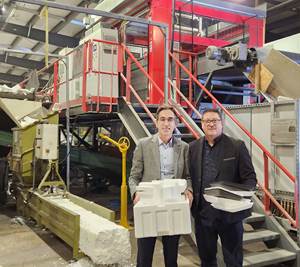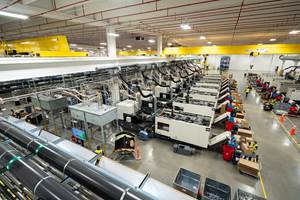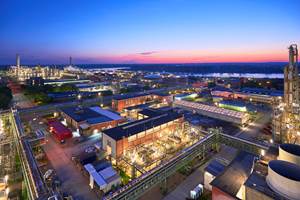Pricing Trajectory is Flat-to-Down for Most Volume Resins
Nylons 6 and 66 are the key exceptions due to tightness of feedstock and resin.
As we head into fourth quarter, a combination of lower prices of some key feedstocks and improvements in both feedstock and resin availability appear to be resulting in a flat-to-lower pricing trend for PE, PP, PS, PVC, PET, ABS and PC. In contrast, tight feedstock and resin availability has been pushing prices upwards for nylons 6 and 66, with more of that trajectory likely to ensue.
Here’s what some of our key industry pros—purchasing consultants from Resin Technology, Inc. (RTi), Fort Worth, Texas; CEO Michael Greenberg of the Plastics Exchange in Chicago; and Houston-based PetroChemWire (PCW) see taking place.
● PE: Prices were a mixed bag in August, with suppliers offering decreases of 3¢/lb in all PE resins to select processors. Meanwhile, Dow delayed its old 3¢.lb increase to September and issued a new 2¢/lb increase. No other supplier took similar action. Mike Burns, RTi’s v.p. of PE markets ventured that the 3¢/lb decrease would likely be realized by the rest of the industry. “We’re now 3-5¢/lb from the bottom, so there is potential to see a total drop of 5¢/lb before year’s end.” The Plastic Exchange’s Greenberg and PCW’s senior editor David Barry, both reported soft spot PE prices, ranging from 1 to 25¢/lb.
Burns noted that August was the highest production month for PE ever while at the same time, due to tariffs from China (which accounts for 8% of U.S. exports) PE exports dropped by about 100-million/lb per month, creating an oversupply situation. However, with very good domestic demand as well as export demand from elsewhere, Burns expects the oversupply to wane. “What’s good for suppliers is that oil prices are up 2% and expected to keep moving up through the rest of the year, creating more opportunity to export.”
As August ended, PCW’s Barry reported PE spot prices as mostly unchanged. “There was no sign of widespread inventory liquidation by producers, who were still negotiating Aug contract prices. LLDPE inventories remained high, while HDPE grades were more balanced. Export demand to China (tariffs) and Turkey (weak domestic currency) was sharply reduced, and alternate markets such as Africa and Latin America were seeing more offers, which prompted weaker sentiment among buyers in those regions.” Barry characterized North American domestic PE sales as steady to slower and added that some larger buyers had built above-normal inventories prior to hurricane season. As such, he reasoned this could translate to a slower apparent demand going into fourth quarter.
Barry also noted that negotiations over August pricing were still said to be ongoing as suppliers had postponed their 3¢/lb increase to September. Meanwhile, on August 31, one supplier reportedly lowered its LLDPE, LDPE and HMWPE film prices by 3¢/lb, while keeping other HDPE grades flat.
● PP: Prices moved up in step with propylene monomer by 2¢/lb in August. However, end-of-month monomer spot prices were moving down, and September contracts were expected to drop, according to Scott Newell, RTi’s vp of PP markets. He ventured that PP prices may have peaked. “The issues with propylene availability have not totally gone away, but we’re seeing some demand destruction for both the monomer and PP.” He also noted that PDH (on-purpose propylene) plants are up and running again after unplanned outages.
Both Greenberg and PCW’s Barry reported a very active spot PP market and overall better availability. Industry sources generally venture that PP prices could drop 2-4¢/lb in the near term. Domestic demand has held up well, noted Newell, but there’s some demand destruction because of the higher prices. PCW’s Barry and Newell both noted that the wide gap between domestic and international prices attracted imports of resin and finished goods.
Barry reported that volumes of imported resin and finished goods are very likely to increase in the September/October timeframe, which would present a headwind to domestic sales. He noted that August domestic sales volumes have been characterized as average, while exports to Mexico were down due to availability of lower-cost international resin in the Mexican market.
● PS: Prices were flat in August, following a 3¢/lb July drop. Price increases of 4¢/lb, effective September 1, were issued by both Americas Styrenics and Total. PCW’S Barry, just reported that latecomer Ineos Styrolution reportedly will raise its September prime transaction prices by 2¢/lb.
Last week, Robin Chesshier, RTi’s v.p. of PE, PS and nylon 6 markets, had ventured that even if the company (Ineos Styrolution) issued a price hike, there would be only partial implementation. “It’s a weak market…demand is slowing, styrene monomer prices have dropped, pressure from benzene prices is insufficient.” Barring a natural disaster, she expected prices this month to largely remain flat and trend downwards through fourth quarter as demand wanes and operating rates decrease further. Chesshier attributed some of this trajectory to styrene monomer export tariffs imposed on China.
PCW’s Barry reported spot PS prices as flat to higher as suppliers prepared to implement September price increases. Implied styrene production costs based on a 30/70 formula of spot ethylene and benzene were essentially flat in the last week of August at 32.8¢/lb compared with 31.6-31.7¢/lb in late July.
● PVC: Prices continued flat through August and were expected to remain as such through last month, with the potential for downward pressure from lower export prices this month, according to Mark Kallman, RTi’s v.p. of PVC and engineering resin markets. Fractional cost pressure from ethylene was insignificant. PCW’s senior editor Donna Todd noted that the 1.25 ¢/lb ethylene hike translates to about a half-cent increase into cost of PVC.
Kallman noted that production rates dropped as demand for exports dropped, but domestic demand was up through much of third quarter, resulting in a fairly balanced market. PCW’s Todd reported that some industry sources expected export prices to continue to soften, with the delta widening between export and domestic prices. She cited one industry pundit as projecting a 1¢/lb drop this month.
However, others ventured the erosion in export pricing to have peaked and reasoned that export prices will not drop again because of the loss of both China and Turkey (driven by tariffs) as destinations for U.S. resin had already been “baked into the market”. PCW’s Todd also ventured that a strengthened demand for PVC within the September-November timeframe, as has been the case in some previous years, could resist any downward pull from lower export pricing.
● PET: Prices for domestic bottle-grade PET ended August at 78-82¢/lb delivered East Coast and West Coast, and at 81-83¢/lb delivered to Midwest locations, including the Chicago area, for truckload business, according to PCW’s senior editor Xavier Cronin. This was up a net 4¢/lb from July. Higher prices were primarily driven by strong demand for PET bottles, packaging and fiber going into consumer products. At the same time, higher costs for PET feedstock in August saw PET prices rise for high-volume domestic PET end users pricing off monthly contracts. PET supply from US plants was actually steady in August from July. Truckload shipments were seen from the Apple Grove plant in West Virginia—Apple Grove, now owned by Taiwan's Far Eastern, saw about eight truckloads of PET booked for delivery to domestic end users in August.
Meanwhile, prices of PET imports were at parity with US prices. PCW says the U.S. remains awash in imported PET due mostly to global PET oversupply, especially in South America and Asia, while the U.S. market remains one of the world's most robust due to its heavy consumption of single-use plastic.
PCW’s Cronin reported PET prices starting September as steady, with the expectation that demand would be strong throughout the month, keeping prices at 1-2 ¢/lb higher as the summertime carbonated beverage and water bottle season winds down. But Cronin anticipated PET prices in October likely to taper off 2-4¢/lb, as a result of the typical seasonal drop in demand coupled by robust PET imports. A ramping up of production at Apple Grove is also expected to add to a somewhat bloated supply picture as the fall season kicks in, according to Cronin.
● ABS: Prices remained fairly stable through most of third quarter as they had in second quarter, following the 5¢/lb increases in January, according to RTi’s Kallman. He expected flat prices in September.
Feedstock prices did not increase sufficiently to allow suppliers to push through a new increase. Benzene, most importantly, despite a 4¢gal increase to $2.88/gal in August, has remained below the $3.00/gal threshold. And small increases in acrylonitrile and butadiene were insufficient to matter.
Kallman ventured some downward pressure could be forthcoming in the fourth quarter from lower cost ABS imports. Demand has been good, in step with GDP growth, driven by automotive and construction.
● PC: Prices held flat through second quarter and this trend was expected to continue through the completion of the third quarter, following implementation of increases of up to 14¢/lb in first quarter, according to RTi’s Kallman. Upward pressure from feedstock, particularly benzene, was not an issue, and despite an unplanned outage, the market remains relatively well balanced.
Kallman also noted that despite planned outages this month and good domestic demand from automotive and construction, inventory buildup would ensure a continued balanced market. He ventured there is potential for downward pressure in fourth quarter from lower cost Asian imports. “However, polycarbonate is on the list of the next tariff round, so this may not materialize.”
● Nylon 6: Prices were expected to move up 3-5¢ in August, following implementation of a 2¢/lb surcharge in July, attributed by suppliers to a shortage of trucks and truck drivers, according to RTi’s Chesshier, who noted that freight costs rose upwards of 40%.
Chesshier anticipated upwards pricing pressure through September and October, with both BASF and AdvanSix (former Honeywell nylon 6 business), having issued 5¢/lb price hikes, effective Sept. 1. In addition to the freight costs, these suppliers attribute their move to tighter supply due to increased demand from processors aiming to switch from nylon 66, along with a tighter caprolactum supply due to unplanned shutdowns. However, because benzene prices have not risen sufficiently, there is potential for only partial implementation.
● Nylon 66: Prices cumulatively rose 10-20¢/lb in third quarter, in addition to the 15-20¢/lb implemented in first quarter, driven by a very tight global market, according to RTi’s Kallman. The seven force majeure actions on intermediates—mostly in Europe, through first and second quarters—were nearly doubled by more unplanned outages through the third quarter.
“Tightness in intermediates is the key problem,” said Kallman. He cited unplanned production disruptions at key intermediate plants—including precursor ADN (adiponitrile) and derivative HMD (hexamethylene diamine) in France and the U.K., attributing them to low water levels that affected cooling of plants and transportation along with other logistical problems such as transportation strikes.
Moreover, the July 10 fire at Ascend Performance’s Pensacola facility led to a force majeure of its nylon 66 resins, compounds and industrial fibers, further tightening this market. Industry sources reported that the plant appeared to have been restarted in early August and was incrementally being brought back to full production, though the force majeure action remained. Said Kallman, “People are doing their best to qualify alternative materials.”
Related Content
Nexkemia Acquires Polystyrene Recycling Assets
The polystyrene manufacturer finalized its purchase of Eco-Captation, a recycler.
Read MoreEV Chargers Made From Renewable PC
SABIC is enabling Charge Amps to manufacture electric vehicle (EV) chargers with a housing made from certified renewable PC, a first for the industry.
Read MoreIPEX Opens Injection Molding Facility in North Carolina
The pipe and fittings manufacturer’s new 200,000-square-foot facility represents a $200 million investment and will create 150 jobs.
Read MoreIneos Nitriles Launches Biobased Acrylonitrile
The company’s Invireo is said to deliver a 90% lower carbon footprint compared to conventionally produced acrylonitrile.
Read MoreRead Next
Processor Turns to AI to Help Keep Machines Humming
At captive processor McConkey, a new generation of artificial intelligence models, highlighted by ChatGPT, is helping it wade through the shortage of skilled labor and keep its production lines churning out good parts.
Read MoreHow Polymer Melts in Single-Screw Extruders
Understanding how polymer melts in a single-screw extruder could help you optimize your screw design to eliminate defect-causing solid polymer fragments.
Read MorePeople 4.0 – How to Get Buy-In from Your Staff for Industry 4.0 Systems
Implementing a production monitoring system as the foundation of a ‘smart factory’ is about integrating people with new technology as much as it is about integrating machines and computers. Here are tips from a company that has gone through the process.
Read More











.png;maxWidth=300;quality=90)


















